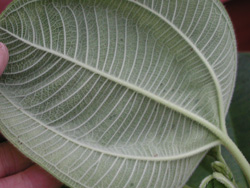Resource Library
Plant of the Week: Large-Leafed Glory Flower
The University of Arkansas System Division of Agriculture does not promote, support or recommend plants featured in "Plant of the Week." Please consult your local Extension office for plants suitable for your region.
Plant of the Week
Large-Leafed Glory Flower
Latin: Tibourchina grandifolia

The tropical look is a distinctive part of the summertime garden. This look revolves around large, bold plants with shockingly bright flowers. Not surprisingly, Brazil is home to many of these beauties. The glory bush or princess flower (Tibouchina) is a large group of tropicals that delivers this look in grand style.
Tibouchina is a genus of over 350 woody shrubs and small trees belonging to the tropical Melastome family and mostly native to the Amazon basin. Several species are in cultivation, with T. grandifolia amongst the most common. They all go by the general names of "glory flower" or "princess flower."
The large-leafed glory flower, the name often associated with T. grandifolia, has large, opposite, hand-sized circular leaves covered with a dense mat of soft hairs that make you want to reach out and pet it. It can grow to 10 feet tall and wide with an open, somewhat irregular form. Close attention to pruning is needed to keep it compact. When stressed by getting dry or a bit chilly, the lower leaves will senesce and change to beautiful shades of yellow and orange.
The name princess flower comes from the royal purple blooms that are produced in the summer at the ends of branches in panicles. The large-leafed glory flower produces a foot-long panicle containing many five-petaled flowers about 1.5 inches across.
T. urvilleana is amongst the showiest Tibouchina in bloom, with flowers twice as large in a more open panicle.
Many glory flowers produce two kinds of stamens. In the base of the flower are short stamenoids that produce nectar and pollen without DNA. These shorter stamens serve as an attractant for various bees and wasps that trigger the longer, arched stamens to release pollen when they rummage in the flower to receive their reward.
Jean Baptiste Aublet (1720-1778) first described the glory flowers in 1775 from material he had collected in French Guiana, the small nation on the northeast corner of South America, where he was sent as a medical doctor for the French East India Company in 1762. The name is a Latinized adaptation of the local Guianese name. It was Celestin Alfred Cogniaux (1841-1916), another French botanist who never did field work in the jungle, who spent years classifying and naming the many glory flowers from Brazil and who brought them to the attention of gardeners in temperate climates.
The large-leafed glory flower is easy to grow in containers, either in full sun or on the partially shaded patio. It is a big plant from the tropics, so it should be planted in a large container and watered often. It can be set in the border, but will only reliably overwinter in southern Florida and southern California. In temperate climates, cuttings can be made in late summer or the original plant can be dug up and taken indoors. It can be overwintered inside in a sunny window or in a heated greenhouse.
By: Gerald Klingaman, retired
Extension Horticulturist - Ornamentals
Extension News - August 27, 2010
The University of Arkansas System Division of Agriculture does not maintain lists of retail outlets where these plants can be purchased. Please check your local nursery or other retail outlets to ask about the availability of these plants for your growing area.